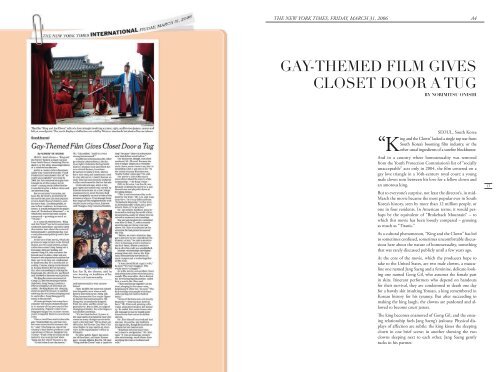The Korean Wave 2006 - Korean Cultural Service
The Korean Wave 2006 - Korean Cultural Service
The Korean Wave 2006 - Korean Cultural Service
Create successful ePaper yourself
Turn your PDF publications into a flip-book with our unique Google optimized e-Paper software.
<strong>The</strong> New York Times, FRIDAY, march 31, <strong>2006</strong><br />
a4<br />
Gay-<strong>The</strong>med Film Gives<br />
Closet Door a Tug<br />
By NORIMITSU ONISHI<br />
SEOUL, South Korea<br />
and the Clown” lacked a single top star from<br />
South Korea’s booming film industry, or the<br />
“King<br />
other usual ingredients of a surefire blockbuster.<br />
And in a country where homosexuality was removed<br />
from the Youth Protection Commission’s list of “socially<br />
unacceptable” acts only in 2004, the film centered on a<br />
gay love triangle in a 16th-century royal court: a young<br />
male clown torn between his love for a fellow clown and<br />
an amorous king.<br />
But to everyone’s surprise, not least the director’s, in mid-<br />
March the movie became the most popular ever in South<br />
Korea’s history, seen by more than 12 million people, or<br />
one in four residents. In American terms, it would perhaps<br />
be the equivalent of “Brokeback Mountain” – to<br />
which this movie has been loosely compared – grossing<br />
as much as “Titanic.”<br />
As a cultural phenomenon, “King and the Clown” has led<br />
to sometimes confused, sometimes uncomfortable discussions<br />
here about the nature of homosexuality, something<br />
that was rarely discussed publicly until a few years ago.<br />
At the core of the movie, which the producers hope to<br />
take to the United States, are two male clowns, a masculine<br />
one named Jang Saeng and a feminine, delicate-looking<br />
one named Gong Gil, who assumes the female part<br />
in skits. Itinerant performers who depend on handouts<br />
for their survival, they are condemned to death one day<br />
for a bawdy skit insulting Yonsan, a king remembered in<br />
<strong>Korean</strong> history for his tyranny. But after succeeding in<br />
making the king laugh, the clowns are pardoned and allowed<br />
to become court jesters.<br />
<strong>The</strong> king becomes enamored of Gong Gil, and the ensuing<br />
relationship fuels Jang Saeng’s jealousy. Physical displays<br />
of affection are subtle: the king kisses the sleeping<br />
clown in one brief scene; in another showing the two<br />
clowns sleeping next to each other, Jang Saeng gently<br />
tucks in his partner.<br />
17





